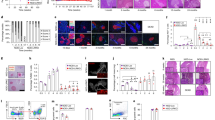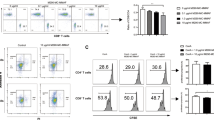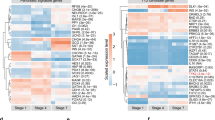Abstract
Protection of β cells from autoimmune destruction potentially cures type 1 diabetes mellitus (T1D). During antigen presentation, interactions between cytotoxic T-lymphocyte antigen-4 (CTLA4) and B7 molecules, or programmed death 1 (PD1) and its ligand PDL1, negatively regulate immune responses in a non-redundant manner. Here we employed β-cell-targeted adeno-associated virus serotype 8 (AAV8)-based vectors to overexpress an artificial PDL1-CTLA4Ig polyprotein or interleukin 10 (IL10). β-Cell-targeted expression of PDL1-CTLA4Ig or IL10 preserved β-cell mass and protected NOD mice from T1D development. When NOD mice were treated with vectors at early onset of hyperglycemia, PDL1-CTLA4Ig or IL10 alone failed to normalize the early onset of hyperglycemia. When drug-induced diabetic mice received major histocompatibility complex (MHC)-matched allo-islets, with or without pretreatment of the PDL1-CTLA4Ig-expressing vector, PDL1-CTLA4Ig-expressing islets were protected from rejection for at least 120 days. Similarly, transplantation of PDL1-CTLA4Ig-expressing MHC-matched islets into mice with established T1D resulted in protection of allo-islets from acute rejection, although islet grafts were eventually rejected. Thus the present study demonstrates the potent immuno-suppressive effects of β-cell-targeted PDL1-CTLA4Ig overexpression against T1D development and allo-islet rejection. The gene-based simultaneous inhibition of PD1 and CTLA4 pathways provides a unique strategy for immunosuppression-free tissue/organ transplantation, especially in the setting of no established autoimmunity.
This is a preview of subscription content, access via your institution
Access options
Subscribe to this journal
Receive 12 print issues and online access
$259.00 per year
only $21.58 per issue
Buy this article
- Purchase on Springer Link
- Instant access to full article PDF
Prices may be subject to local taxes which are calculated during checkout





Similar content being viewed by others
References
Daneman D . Type 1 diabetes. Lancet 2006; 367: 847–858.
Bluestone JA, Herold K, Eisenbarth G . Genetics, pathogenesis and clinical interventions in type 1 diabetes. Nature 2010; 464: 1293–1300.
Chatzigeorgiou A, Harokopos V, Mylona-Karagianni C, Tsouvalas E, Aidinis V, Kamper EF . The pattern of inflammatory/anti-inflammatory cytokines and chemokines in type 1 diabetic patients over time. Ann Med 2010; 42: 426–438.
Holditch SJ, Terzic A, Ikeda Y . Concise review: pluripotent stem cell-based regenerative applications for failing beta-cell function. Stem Cells Transl Med 2014; 3: 653–661.
Herold KC, Hagopian W, Auger JA, Poumian-Ruiz E, Taylor L, Donaldson D et al. Anti-CD3 monoclonal antibody in new-onset type 1 diabetes mellitus. N Engl J Med 2002; 346: 1692–1698.
Herold KC, Gitelman SE, Masharani U, Hagopian W, Bisikirska B, Donaldson D et al. A single course of anti-CD3 monoclonal antibody hOKT3gamma1(Ala-Ala) results in improvement in C-peptide responses and clinical parameters for at least 2 years after onset of type 1 diabetes. Diabetes 2005; 54: 1763–1769.
Sherry N, Hagopian W, Ludvigsson J, Jain SM, Wahlen J, Ferry RJ Jr et al. Teplizumab for treatment of type 1 diabetes (Protege study): 1-year results from a randomised, placebo-controlled trial. Lancet 2011; 378: 487–497.
Staeva TP, Chatenoud L, Insel R, Atkinson MA . Recent lessons learned from prevention and recent-onset type 1 diabetes immunotherapy trials. Diabetes 2013; 62: 9–17.
Shapiro AM, Ricordi C, Hering BJ, Auchincloss H, Lindblad R, Robertson RP et al. International trial of the Edmonton protocol for islet transplantation. N Engl J Med 2006; 355: 1318–1330.
Ryan EA, Paty BW, Senior PA, Bigam D, Alfadhli E, Kneteman NM et al. Five-year follow-up after clinical islet transplantation. Diabetes 2005; 54: 2060–2069.
Barton FB, Rickels MR, Alejandro R, Hering BJ, Wease S, Naziruddin B et al. Improvement in outcomes of clinical islet transplantation: 1999-2010. Diabetes Care 2012; 35: 1436–1445.
Bellin MD, Kandaswamy R, Parkey J, Zhang HJ, Liu B, Ihm SH et al. Prolonged insulin independence after islet allotransplants in recipients with type 1 diabetes. Am J Transplant 2008; 8: 2463–2470.
Robertson RP . Islet transplantation as a treatment for diabetes - a work in progress. N Engl J Med 2004; 350: 694–705.
Hirshberg B, Rother KI, Digon BJ 3rd, Lee J, Gaglia JL, Hines K et al. Benefits and risks of solitary islet transplantation for type 1 diabetes using steroid-sparing immunosuppression: the National Institutes of Health experience. Diabetes Care 2003; 26: 3288–3295.
Ojo AO, Held PJ, Port FK, Wolfe RA, Leichtman AB, Young EW et al. Chronic renal failure after transplantation of a nonrenal organ. N Engl J Med 2003; 349: 931–940.
Nir T, Melton DA, Dor Y . Recovery from diabetes in mice by beta cell regeneration. J Clin Invest 2007; 117: 2553–2561.
Rostambeigi N, Lanza IR, Dzeja PP, Deeds MC, Irving BA, Reddi HV et al. Unique cellular and mitochondrial defects mediate FK506-induced islet beta-cell dysfunction. Transplantation 2011; 91: 615–623.
Potter KJ, Westwell-Roper CY, Klimek-Abercrombie AM, Warnock GL, Verchere CB . Death and dysfunction of transplanted beta-cells: lessons learned from type 2 diabetes? Diabetes 2014; 63: 12–19.
Linsley PS, Brady W, Grosmaire L, Aruffo A, Damle NK, Ledbetter JA . Binding of the B cell activation antigen B7 to CD28 costimulates T cell proliferation and interleukin 2 mRNA accumulation. J Exp Med 1991; 173: 721–730.
Butte MJ, Keir ME, Phamduy TB, Sharpe AH, Freeman GJ . Programmed death-1 ligand 1 interacts specifically with the B7-1 costimulatory molecule to inhibit T cell responses. Immunity 2007; 27: 111–122.
Fife BT, Pauken KE, Eagar TN, Obu T, Wu J, Tang Q et al. Interactions between PD-1 and PD-L1 promote tolerance by blocking the TCR-induced stop signal. Nat Immunol 2009; 10: 1185–1192.
Curran MA, Montalvo W, Yagita H, Allison JP . PD-1 and CTLA-4 combination blockade expands infiltrating T cells and reduces regulatory T and myeloid cells within B16 melanoma tumors. Proc Natl Acad Sci USA 2010; 107: 4275–4280.
Orban T, Bundy B, Becker DJ, Dimeglio LA, Gitelman SE, Goland R et al. Costimulation modulation with abatacept in patients with recent-onset type 1 diabetes: follow-up 1 year after cessation of treatment. Diabetes Care 2014; 37: 1069–1075.
Tonne JM, Sakuma T, Deeds MC, Munoz-Gomez M, Barry MA, Kudva YC et al. Global gene expression profiling of pancreatic islets in mice during streptozotocin-induced beta-cell damage and pancreatic Glp-1 gene therapy. Dis Model Mech 2013; 6: 1236–1245.
Xiao X, Gaffar I, Guo P, Wiersch J, Fischbach S, Peirish L et al. M2 macrophages promote beta-cell proliferation by up-regulation of SMAD7. Proc Natl Acad Sci USA 2014; 111: E1211–E1220.
Tonne JM, Sakuma T, Munoz-Gomez M, El Khatib M, Barry MA, Kudva YC et al. Beta cell regeneration after single-round immunological destruction in a mouse model. Diabetologia 2014; 58: 313–323.
Mueller C, Braag SA, Martino AT, Tang Q, Campbell-Thompson M, Flotte TR . The pros and cons of immunomodulatory IL-10 gene therapy with recombinant AAV in a Cftr-/- -dependent allergy mouse model. Gene Therapy 2009; 16: 172–183.
Yang Z, Chen M, Wu R, Fialkow LB, Bromberg JS, McDuffie M et al. Suppression of autoimmune diabetes by viral IL-10 gene transfer. J Immunol 2002; 168: 6479–6485.
van Belle TL, Coppieters KT, von Herrath MG . Type 1 diabetes: etiology, immunology, and therapeutic strategies. Physiol Rev 2011; 91: 79–118.
Zmuda EJ, Powell CA, Hai T . A method for murine islet isolation and subcapsular kidney transplantation. J Vis Exp 2011; 13: 2096.
Acknowledgements
This work was supported by the Mayo Foundation, Eisenberg Stem Cell Trust, Minnesota Partnership Grant (to YI), Mayo Center for Regenerative Medicine (to YI and TS) and National Institutes of Health (HL098502 to YI).
Author information
Authors and Affiliations
Corresponding author
Ethics declarations
Competing interests
The authors declare no conflict of interest.
Rights and permissions
About this article
Cite this article
El Khatib, M., Sakuma, T., Tonne, J. et al. β-Cell-targeted blockage of PD1 and CTLA4 pathways prevents development of autoimmune diabetes and acute allogeneic islets rejection. Gene Ther 22, 430–438 (2015). https://doi.org/10.1038/gt.2015.18
Received:
Revised:
Accepted:
Published:
Issue Date:
DOI: https://doi.org/10.1038/gt.2015.18
This article is cited by
-
Novel human immunomodulatory T cell receptors and their double-edged potential in autoimmunity, cardiovascular disease and cancer
Cellular & Molecular Immunology (2021)
-
Encapsulation Strategies for Pancreatic Islet Transplantation without Immune Suppression
Current Stem Cell Reports (2021)
-
The Role of Programmed Death-1 in Type 1 Diabetes
Current Diabetes Reports (2021)
-
Current progress in stem cell therapy for type 1 diabetes mellitus
Stem Cell Research & Therapy (2020)
-
The state of the art of islet transplantation and cell therapy in type 1 diabetes
Acta Diabetologica (2016)



